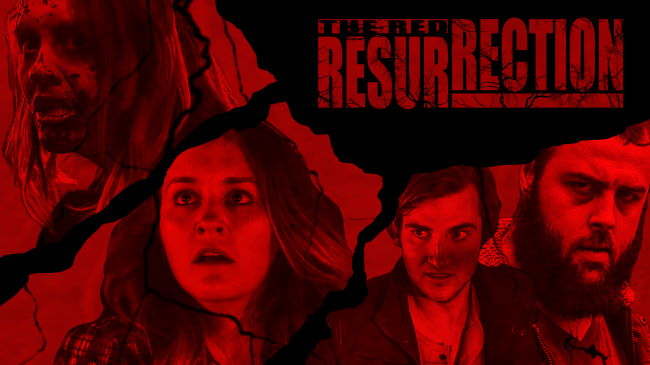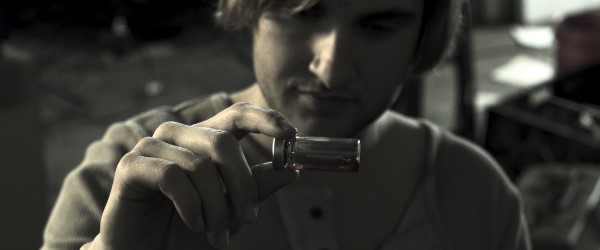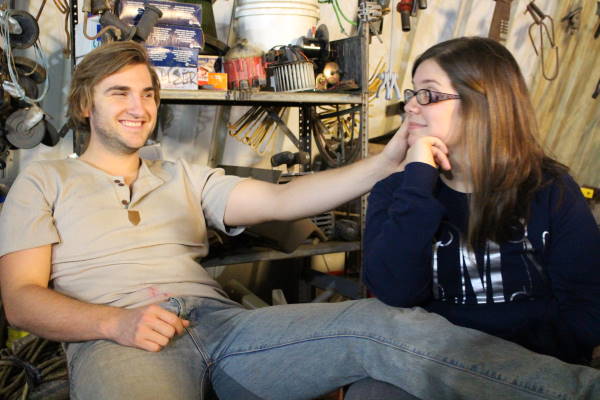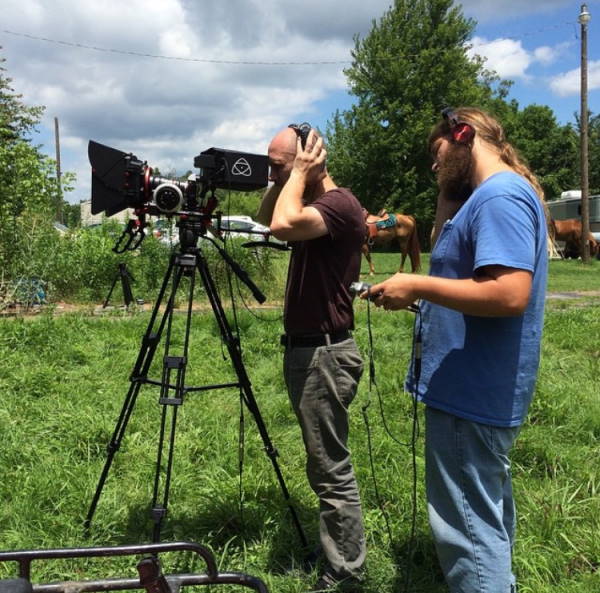Hi, this is Barry and welcome to my site. In this article, I’d like to talk about an independent film called The Red Resurrection, written and directed by Matt Long. The story follows a group of people who hold the cure to a deadly plague that has swept the planet. It is an impressive take on the zombie-apocalypse that focusses on second chances in addition to survival. The film has terrific visuals and the cinematography is exceptional. Everyone in the movie is a first timer in their respective roles in the context of a full-length feature film. It’s challenging to bring together a movie without the cost blowing up in your face. The Red Resurrection is shot in great locations and gives that perfect post-apocalyptic feel.
The film follows a duo who happen to administer the cure to an undead woman, one struggling with the ghosts of her own past. After that, the three of them begin their journey back to what they claim is their safe haven and the source of the cure. I loved what Daniel Cutteridge brings to his character, he’s someone I could connect with most. The Red Resurrection shows us how one doesn’t have to be infected by plague to be a monster. We’re shown that in the face of adversity, there are people who can be worse than the undead. In this article we’re going to be chatting with the director to know what it takes to complete a film in a shoestring budget. How every aspect is a learning, and that fight sequences are probably the toughest things to shoot.
Do give this movie a watch. Here are all the details you’ll need about the film.
Movie Website: https://redresurrectionmovie.com/
Facebook: https://www.facebook.com/theredresurrection/
IMDB: https://m.imdb.com/title/tt11167046/?ref_=nv_sr_srsg_0
The Red Resurrection: Interview With Director Matt Long
I happened to do this interview with the director Matt Long where he shares some fantastic insights about the film, the characters, and the production.
This Is Barry: Congratulations on your first full-length feature film, Matt, it’s a solid film with a sound message. Looks like it was the first for many on the team. How did it all come together?
Matt: I had been working with a great team of volunteers for many years on short films and other video projects for our church. So I had already built a team of talented people who knew what it took to make things happen during production.
When I decided it was time to make our first feature, The Red Resurrection, I held a meeting and presented the idea of a zombie film about a cure to bring the undead back to life to them and anyone else who wanted to be involved. As always, they all rallied around me and we started this arduous journey together.
When I finished writing the film, myself and my assistant director, Megan McPeek, who also wore many hats during production, started planning and casting. Some of the actors, like our lead, Kirstie Piper, also Rick Boling, Daniel Cutteridge, and Michael Marks, had been in a few of my others films so we had an idea of what role was best for each of them. I even specifically wrote the role of Jon Bowman for Daniel Cutteridge and he certainly didn’t disappoint with his powerful performance. I couldn’t imagine anyone else playing that character. There were, however, others among the cast though that took a little convincing. And, after filling out the majority of the cast, we eventually came to a point when I was wondering who we’d get to play the characters of Dave Harper and Lincoln Marx. In the end, I took on the role of Lincoln because I knew what I wanted and we couldn’t seem to find the right fit for the role. (However, if I’d known how hard it’d be to learn to ride that horse, I may have cast someone else. That horse and I did not get along.) Then we were able to finally find newcomer Jacob Reinhard and cast him as Dave. Jacob had never done any acting to this level before, but ended up doing a great job in the role.
When we first started production we would make a shooting schedule and, with lots of wishful thinking, thought we could be done in three months. However, when you’re working with 100% volunteers (And by volunteers, I mean that no one got paid. No one in the cast or crew. No one.) and trying to plan around everyone’s work schedule and family life it can get a bit hairy. We planned and scheduled and rescheduled and then rescheduled again. It took us nine months to finish production, from April of 2015 through just before Christmas that year. Everyone was gracious though and continued to agree to dragging it out as long as needed until we finished.
We filmed in every season, from the scorching one hundred degree days of summer to the freezing winter when we would all huddle around a heater in between takes. All of these guys were real troopers and stuck it out. While finally crossing the finish line was quite a relief, it was bittersweet because of how close we all had grown during that time. We had become quite a tight-knit group. A film family, if you will. We even had two of the actors/crew, Jacob Reinhard and Megan McPeek, begin dating during production. They ended up getting married about 8 months before the filmed was released and now they have a beautiful daughter. I’m still in touch with a lot of these guys. Each of our lives has moved on, but we built relationships that will last a lifetime.
This Is Barry: Wow, that’s quite the story. Curious to know why you picked the sub-genre of the zombie apocalypse for your first film. Are you a big fan of the sub-genre?
Matt: To be honest, even though I’ve seen many zombie films, I’ve never been a fan of the genre. A good number of zombie flicks, but not all, rely too much on gore and don’t have enough depth to their characters. I definitely wanted The Red Resurrection to be something different. However, I have always been a big fan the Resident Evil video games, which is a phenomenal zombie franchise. I’m sure that helped influence some of my decisions in storytelling.
This Is Barry: Oh yeah, I agree, Resident Evil is a solid game franchise. There have been many films based on zombies over time, and they tend to revolve around survival or identifying a cure. The Red Resurrection is centred on the cure right from the get-go. How did you conceive this angle to the story?
Matt: It literally came from a dream. One of the individuals I used to work with regularly came to me about a dream they had. It involved a group of us riding around in a Jeep trying to escape from some zombies. Apparently, one of the undead managed to jump onto the Jeep and tried to attack us, but, thankfully, we had this antidote that could bring them back so we cured them.
I don’t remember much else about what they told me of the dream, however, that concept of a cure for the undead got stuck in my brain. I tossed it around for a while trying to develop a basic idea of how the story could play out until the framework of a group of survivors going out into a danger-filled world to cure the undead came into place.
I initially wrote it as a short film that focused on Jon (Daniel Cutteridge) and Dave (Jacob Reinhard) and there initial encounter with Abby (Kirstie Piper) that we could use to help raise funds to make the feature. But, after the short script sat there and the concept germinated, I decided I would just write the feature and now, the rest is history.
This Is Barry: Woah, the plot incepted itself via a dream! How cool is that! One of the themes came across strongly in The Red Resurrection was, “the monster within”. That one doesn’t need to be a zombie to be a monster. Was this always the central message you were going for in the movie or did it evolve?
Matt: It was actually a little of both. I had always planned for Abby’s character to have a broken past and for her personal struggle with that issue. However, as I wrote the characters and really through stellar performances as we shot the film, there were aspects of this theme that kept showing up. We see this most prominently in Abby’s dad, as he is a monster any way you look at him, but then you see characters like Schneider(Michael Marks) or Brother Eli(Jerry Pyle) who didn’t have to be a zombie to be a real monster.
Real monsters aren’t hiding in the closet or under the bed. “They are men who have forgotten mercy, men without honor and justice. That’s the true plague in our world today.” As stated by Paulie (Rick Boling) in the film.
This Is Barry: It’s great to see characters showing compassion for the undead because they know what it is like. The film talks about a second chance not only at life but also at death. This an interesting perspective, would you like to elaborate on this?
This is a film about second chances and you making the decision of who you’ll be as we see with the climax of Abby’s inner conflict towards the finale of the film. Now that she’s been brought back from being one of the undead, or ‘resurrected’ as they call it, will she continue to be who she was before she became infected? Or will she let the guilt of what she did as a mindless zombie haunt her for the rest of her life? She has a choice to make. She’s been given a second chance. And I know I’m quoting the movie here again, but Dave asks her, “Who will this Abigail be?” As each of us has a new chance at life everyday, I think we should ask ourselves that question. Who will we be?
As for a second chance at death, that wasn’t necessarily a point I was trying to make. However, it does always amaze me at what people take away from the film. That’s the great thing about filmmaking. You can have a message or point you’re trying to make, but once it’s out there in the world it can take on a whole new meaning to each person who sees it.
This Is Barry: I would like to talk about the exceptional cinematography and camera work in The Red Resurrection. This looks like an area of production very close to your heart. Would like to talk about the kind of gear you used to shoot the film?
Matt: I wanted this to be the best film I’d ever made and to do that I was gonna have to step up my game. I had recently changed jobs right before we started on the film and I had a few grand sitting in a 401k. After a discussion with my wife, I ended up taking it out and investing it in a new camera, recorder and Cine lenses. These three purchases alone were almost half the budget of the film. For video, we shot in 4K on a Sony A7s with Rokinon Cine Lenses. I chose the A7s in hopes it would give us a clean sharp image even in low light. I was not disappointed. Also, the A7s couldn’t handle the 4K internally so we recorded it on a Atomos Shogun. Both the camera and the recorder had just been released on the market in late 2014/early 2015 and we were taking a chance on the new tech, but it certainly paid off.
We recorded all the audio on a Sennheiser ME 67 shotgun microphone and ran that through a Zoom H4n handheld recorder. Oh, and we had lights, plenty of lights. None of them were big or fancy. We only had a handful that were even LEDs. Some were even painters lights you might pick up at a hardware store. With really very little budget, you learn to use what you have.
This Is Barry: The character you played in The Red Resurrection, Lincoln, is a mysterious one. Was he the case of the monster within or the plague within or a mix of both?
Matt: I believe Lincoln was more of the plague within. But, to go a bit deeper you see how his battle against the plague and how he has tried to hide it, mirrors his own internal struggle to do what is necessary to survive in this apocalyptic world while he is struggling against the outward pressures to become a heartless killer or a crazed lunatic like his brother. There was a line of Lincoln’s that made it into the second trailer, but that eventually had to be cut that I believe perfectly embodies his character. He says, “I don’t always have to like what I do to protect my people, I just have to do it.”
This Is Barry: Would you like to talk about the metaphor associated with the character Joshua?
Matt: I believe as humans, being the broken creatures we are, are all looking for a savior, whatever form that comes in. Here in America, we are hoping that the next president or elected official or law that’s enacted will incite change in our world. Sadly, what most people don’t realize is that change isn’t something that’s going to come so much from an outside source. The change that’s desired has to happen inside of each individual. When you fix the brokenness in each person, that in turn will change our world. Joshua is an embodiment of that savior we each need. There is a problem in the world where all these characters live: a deadly plague that turns everyone it touches into cannibalistic monsters. Joshua alone holds the key to the cure in his blood. But, the cure has to be administered to each individual to bring them back. Also, I am a man of the Christian Faith and my beliefs strongly influence all my storytelling. This film is one of those stories.
There is actually a video on the film’s website that explains this metaphor in depth. If anyone wants to know more about it, they can head over there and check it out.
This Is Barry: The locations in The Red Resurrection were amazing. It sorta gave a timeframe to how long it has been since the plague outbreak without explicitly stating it.
Matt: Thanks! That was the goal: show, don’t tell. Each of those locations were key in helping sell the narrative. I’m so glad we were able to find and obtain permission to use such great places. The film’s finale was actually shot at two different locations. We initially had an old factory that we were hoping to use for the whole scene, but somewhere around a third of the way through filming there, we were informed that we only had a few days and we had to be out. So we had to quickly finish the scenes we had already started there and begin searching to find a place to do the whole trial/zombie horde scene. Thank God, there was a local pastor we knew whose church was under construction. It looked close enough to what we were wanting so we asked and he allowed us to finishing filming the scene there.
This Is Barry: Looks like you did a lot of heavy lifting in The Red Resurrection. How many aspects of the filmmaking did you work on?
Matt: It’s probably easier to say which aspects I didn’t work on. I’ve learned through many years of independent filmmaking, that you just have to make it happen. If that means writing, directing, acting, editing, doing visual effects, etc., you, as the storyteller, do whatever it takes. And if you don’t know how, you learn how. I guess to a certain degree it makes you a jack of all trades and master of none, but at least you’re not sitting around waiting on someone to hand you several million dollars to go and make your dream come true. You just write the story you know you can tell with what you have. Then you go out with a little bit of talent, the right tools, favor, faithful friends, and maybe some ignorance and faith(sometimes you’re unsure which it is) and just do it.
But, to fully answer your question, I did all aspects of preproduction with the exceptions of scheduling and some costuming myself. I was the director, the cinematographer, main camera operator, gaffer, and a few other things during production on top of playing the role of Lincoln. I ended up having to train my assistant director and audio tech to run the camera and recorder for when I had to be in front of it.
With that said, I did have a lot of very talented and dedicated people who helped during production. There’s no way I could have done it without them. But then came the two years of post production, which was me in my studio on evenings and weekends and any other time I could squeeze in to finish the film. The only part of post that I didn’t really do was audio mastering. I was there giving direction most of the time, but I didn’t actually do it myself. That was Dennis Piper of White Horse Recording Studio, who did a stellar job of cleaning up and leveling out all our audio plus fixing any mishaps. Again, as many roles as I had to play to make this film happen, I couldn’t have done it without the help and support of my family and friends.
This Is Barry: A lot of insightful information there Matt, thanks for this interview. What is your next project? Do you have a concept or a genre in mind already?
Matt: I am currently writing my next feature film, a sci-fi mystery with some 80’s vibes. It’s working title is Through the Window and I hope to start filming next year (2021).
This Is Barry: Can’t wait to watch Through The Window Matt, and here’s wishing you the best of luck.

Barry is a technologist who helps start-ups build successful products. His love for movies and production has led him to write his well-received film explanation and analysis articles to help everyone appreciate the films better. He’s regularly available for a chat conversation on his website and consults on storyboarding from time to time.
Click to browse all his film articles



